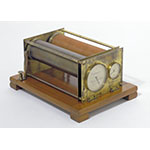Variable resistance made by Filippo de Palma and described in 1843 by Charles Wheatstone. A mahogany base carries a mahogany cylinder and a brass cylinder, each turned by a crank (missing). An uninsulated conductor wire is wound around the two cylinders. The more the windings on the mahogany cylinder, the greater the resistance of the rheostat. If the wire is wound on the brass cylinder instead, it is short-circuited and the overall resistance decreases. Two silvered dials indicate the length of wire wound on the cylinders.
Inventors
Makers
Typology
Context










